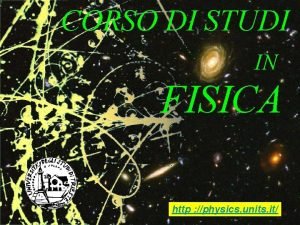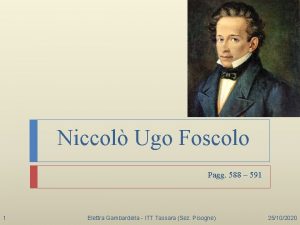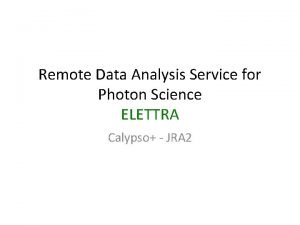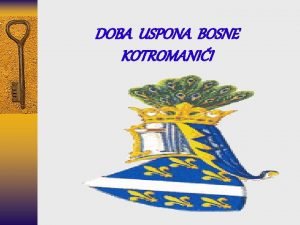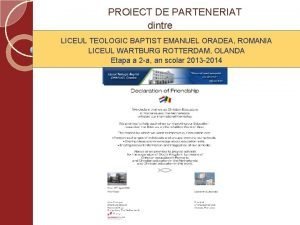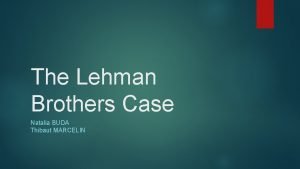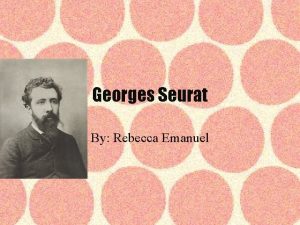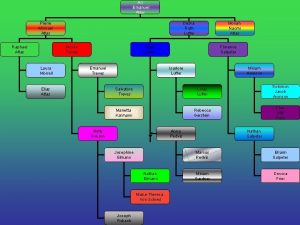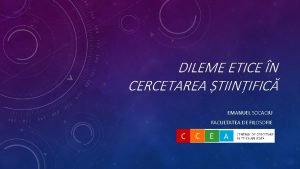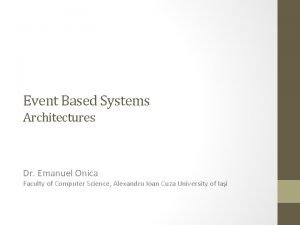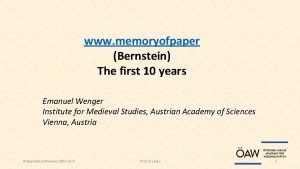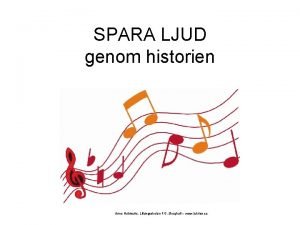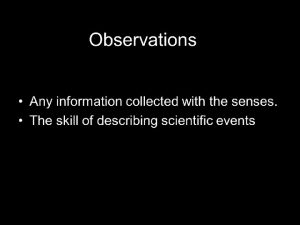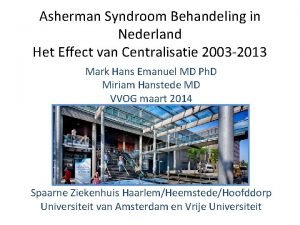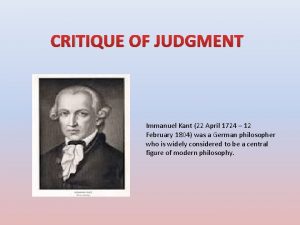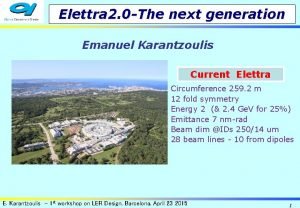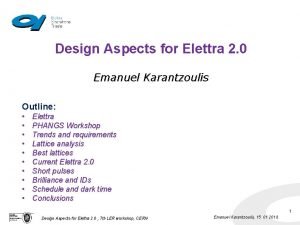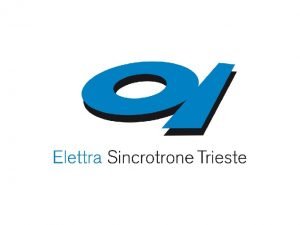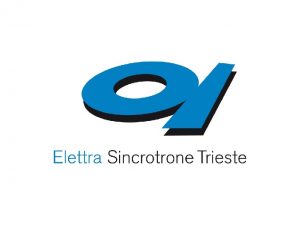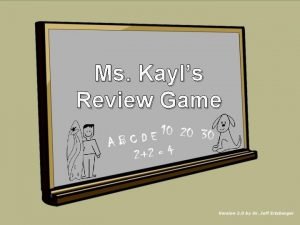Elettra 2 0 Next machine Emanuel Karantzoulis Elettra

























- Slides: 25

Elettra 2. 0 - Next machine Emanuel Karantzoulis Elettra FERMI (FEL) LER 2014 - Frascati 17/9 E. Karantzoulis 1

Outline future requirements of Elettra users' is Elettra defined in collaboration with the external user For optics studies used: q Why change it community, a panel review and the SAC. MAD 8 q Requirements OPA q Elettra 2. 0 Elegant q Possible Solutions q Outlook The q LER 2014 - Frascati 17/9 E. Karantzoulis 2

Current Elettra Circumference 259. 2 m Energy 2 and 2. 4 Ge. V Emittance 7 nm-rad & 1% coupl Beam dim @IDs 250/14 um alpha=1. 6 x 10 -3 Tune 14. 3, 8. 2 E_spread 7. 9 10 -4 DE/turn 254 ke. V, Damping times (msec) X 10. 4, Y 13. 6 E 8 Bends: field 1. 2 T and gradient 2. 86 T/m Quads: max gradient 15 T/m Sext: max gradient 70 T/m 2 Chamber 82 x 53 and 73 x 9 mm (straights ) LER 2014 - Frascati 17/9 E. Karantzoulis 3

Why change it? Elettra is a really good machine with large margins for “improvements” Energy: Elettra operates 25% of its user time at 2. 4 Ge. V. It can go up to 2. 7 Ge. V with a minimum cost Emittance: can go to 2. 5 nmrad (if no achromat) Brilliance Vertical beam size: increase x 2 and To control coupling, skew quads are needed. Preliminary studies quads are needed. smaller spot size (EKarantzoulis + S. Di Mitri, IPAC 2014) show that – no cost with 12 additional magnets, coupling can be as low as 0. 1% LER 2014 - Frascati 17/9 E. Karantzoulis 4

But… After 20 years of continuous user operation: q Beam lines need updating and new instruments / improvements q Parts of support engineering need replacement q Parts of Machine subsystems are outdated (electronics, control boards etc. ) q Machine itself will be outdated if not keeping up with new ideas May be easier to obtain money for a new machine (within limits) than asking money for heavy maintenance ? Our strategy therefore is to look for a new machine trying to maintain/advance however the present one for a low cost. LER 2014 - Frascati 17/9 E. Karantzoulis 5

Characteristics of the new machine As a first step a bottom up approach was tried i. e. discussed with beam lines people to orientate: Was it helpful? LER 2014 - Frascati 17/9 E. Karantzoulis 6

Characteristics of the new machine A bit confusing! decided to concentrate on brilliance and size letting the energy issue for later i. e. assumed for the moment same energy and circumference q q Increased brilliance (how much? At least 1 order ) Reduced beam size More intensity (typical) Machine energy higher but not clear on photon energy As a second step a workshop with users was organized in April: there was more concern about updating the beam lines but showed interest in brightness, coherence and spot size! Finally a decision with the management achieved i. e. top down worked LER 2014 - Frascati 17/9 E. Karantzoulis 7

Brightness Example: brightness increase vs photon energy for various electron beam emittance for a 46 mm undulator LER 2014 - Frascati 17/9 E. Karantzoulis 8

Coherent Fraction Transverse coherence or spatial coherence or coherent fraction describes the degree to which the phase of the wave is correlated at two distinct points in the transverse plane. In the coherence regime: At 1 ke. V with: 7 nm rad CF is 1. 5% 0. 3 nmrad CF is 23% LER 2014 - Frascati 17/9 E. Karantzoulis 9

M-bend candidate lattices for Elettra 2. 0 LER 2014 - Frascati 17/9 E. Karantzoulis 10

M-bend achromats and emittance Lattices up to 9 -bend achromats have been produced and examined Elettra nominal: at 2 Ge. V 7000 pm-rad (and at 2. 4 Ge. V 10000 pm-rad) LER 2014 - Frascati 17/9 E. Karantzoulis 11

Free space LER 2014 - Frascati 17/9 E. Karantzoulis 12

Elettra 2. 0: Users and management (mainly) requirements q q q q q Same building, same circumference C~259 -260 m Energy 2 Ge. V Brilliance increase at 1 ke. V by more than 1 order of magnitude H-spot size less than 40 um Multi-bunch current 400 m. A, maintain the filling patterns as before (hybrid, single bunch etc. ) Maintain the existing ID straight sections Maintain the existing bending magnet beam lines free space not less than that of Elettra, LS: 6 m (4. 5 for Ids) + (SS: 1. 1 m , SLS: 1. 46 m for RF / short IDs / instruments) total 8. 56 m Use off axis injection 6+6 months downtime for installation and commissioning LER 2014 - Frascati 17/9 E. Karantzoulis 13

A possible candidate N-bends sx ( um) ID Emittance (nmrad) sy (um) ID 240 sy (um) @1% coupl ID 2 7 14 4 0. 82 70 43 4. 3 5 0. 65 40 30 3 6 0. 25 32 32 3. 2 7 0. 19 29 29 2. 9 8 0. 12 25 22 2. 2 9 0. 087 18 17 1. 7 To save space elements should be combined as much as possible: Defocusing in dipoles Skew quads + correctors Sextupoles + correctors BPM inside the quadrupoles Lateral pumping etc LER 2014 - Frascati 17/9 E. Karantzoulis 14

6 -BA Energy 2 Ge. V Emittance 0. 251 nmrad -> 28 times reduction Beam dim 32/22 um (round beam) or 40/2. 2 um at 1% coupling alpha=3 x 10 -4 -> shorter bunches by a factor of 2 Tune 33. 32, 8. 38, chrom -60 Espread 7 10 -4 DE/turn 178. 5 ke. V, Damping times (msec) X 12. 4, Y 19. 3 E 13. 5 LER 2014 - Frascati 17/9 E. Karantzoulis Dipoles: field 0. 8 T and gradient 19 T/m Quads: K max 9. 5 -> 64 T/m -> 12. 8 T (l=0. 2 m) Sext: max K 2=100 (700 T/m 2) Chamber 22 x 7 mm and 22 x 22 Elettra nominal: Dipoles: field 1. 2 T and gradient 2. 86 T/m Quads: max gradient 15 T/m Sext: max gradient 70 T/m 2 15

6 BA – version 1/2 Low dispersion - Beam dimensions in shorts straights match the long ones Another solution with 2 T “super-bends” at the arc extremes, but 0. 33 nmrad LER 2014 - Frascati 17/9 E. Karantzoulis 16

Most probable candidate Long 6. 63 m middle 1. 6 m short 0. 58 m LER 2014 - Frascati 17/9 E. Karantzoulis 17

Tunnel fit In fact in order to fit, Elettra 2. 0 is 300 mm longer, arc 400 mm Better, arc only 285 mm LER 2014 - Frascati 17/9 E. Karantzoulis 18

Dynamic aperture The dynamic aperture is reduced but it is still quite acceptable 240 s 500 s Elettra Reduction by a factor of about 3 (=6/2) i. e. ~1/Nd LER 2014 - Frascati 17/9 E. Karantzoulis Elettra 2. 0 - Not yet optimized Work in progress 19

Dipoles and quadrupoles Not final but important to see also the dimensions. Use of new materials such as Cobalt – Iron alloys will also be considered Opera, D. Castronovo LER 2014 - Frascati 17/9 E. Karantzoulis 20

Brilliance vs. emittance for an undulator for Soft X-rays 20 x 15 x Elettra : 7 nmrad Beam dimensions: x, y (245, 14) mm x’, y’ (28, 6 ) mrad Long straights - 0. 25 nm-rad 4 x Beam dimensions: x, y (43, 3. 0) mm x’, y’ (5. 7, 0. 8 ) mrad Super ESCA @ 2 Ge. V 100 m. A Graph by B. Diviacco Brilliance increasing as expected Spot size/div decreased by a factor of 5 LER 2014 - Frascati 17/9 E. Karantzoulis 0. 25 nm-rad – short straights Beam dimensions: x, y (45, 3. 1) mm x’, y’ (8, 0. 9 ) mrad 21

Brilliance vs. emittance for a wiggler (Hard X-rays) 7 nm-rad Beam dimensions: x, y (245, 14) mm x’, y’ (28, 6 ) mrad 0. 25 nm-rad Beam dimensions: x, y (43, 3) mm x’, y’ (5. 7, 0. 8 ) mrad Brilliance increasing by one order of magnitude Spot size/div decreasing by a factor of 5 LER 2014 - Frascati 17/9 E. Karantzoulis 22

Brilliance vs. emittance for a short wiggler vs bending 7 nm-rad - dipole Beam dimensions: x, y (150, 28) mm x’, y’ (240, 6) mrad 0. 25 nm-rad – short straights Beam dimensions: x, y (45, 3. 1) mm x’, y’ (8, 0. 9 ) mrad Short wiggler: 2 T , 1 m 14 cm period Brilliance increases Spot size/div decreases significantly LER 2014 - Frascati 17/9 E. Karantzoulis 23

Elettra and Elettra 2. 0 Parameter Units Circumference m 259. 2 259. 6 Energy Ge. V 2 - 2. 4 2 Horizontal emittance pmrad 7000 250 Vertical pmrad 70 (1% coupl) emittance Current Elettra 2. 0 2. 5 (250 round beam) Beam size @ ID (sx, sy) mm 245 , 14 (1% coupl) 43, 3 (31, 22 beam) Beam size at short ID mm 350 , 22 (1% coupl) 45, 3 (39, 21 beam) Beam size @ Bend mm 150, 28 (1% coupl) 17, 7 (12, 48 beam ) Bunch length ps Energy spread DE/E % 0. 08 Bending angle degree 15 LER 2014 - Frascati 17/9 E. Karantzoulis 25 (100 with 3 HC ) round 12. 5 (70 -100 with 3 HC ) 0. 07 5. 5 and 4 24

Outlook q q In October 2014 starts the conceptual design project until 5/2016 (people busy with FERMI 2 commissioning and the operations of both machines: Elettra and FERMI 1 run for users) During this period optics solution should be fixed with all beam dynamics. Magnets and subsystems should be defined. Once money is found we roughly estimate 50 persons for 4 years i. e. the earliest possible Elettra 2. 0 date for users is 2021 Cost ~80 -100 M€ LER 2014 - Frascati 17/9 E. Karantzoulis 25
 X.next = x.next.next
X.next = x.next.next Elettra malossi
Elettra malossi Differenze tra eschilo e sofocle
Differenze tra eschilo e sofocle Units fisica
Units fisica Fase freud
Fase freud Elettra sepolcri
Elettra sepolcri Vuo elettra
Vuo elettra Emanuel komnen
Emanuel komnen Liceul teologic baptist emanuel
Liceul teologic baptist emanuel Emanuel lehman
Emanuel lehman Rebekah emanuel
Rebekah emanuel Emanuel kittl
Emanuel kittl Egg för emanuel
Egg för emanuel Rebecca gerstein
Rebecca gerstein Consideratii etice ale cercetarii
Consideratii etice ale cercetarii Emanuel wüthrich
Emanuel wüthrich Emanuel onica
Emanuel onica Evanyely zamorano
Evanyely zamorano Filacad
Filacad Elektro emanuel
Elektro emanuel Emanuel timoni
Emanuel timoni 1806 valentin ross
1806 valentin ross Mrkh syndroom
Mrkh syndroom Emanuel coman tcd
Emanuel coman tcd Emanuel kanti
Emanuel kanti George washington crossing the delaware painting
George washington crossing the delaware painting



